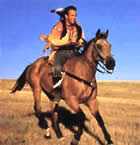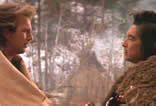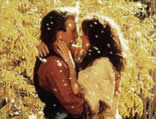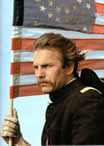Michael Blake On Adaptation: Dances With Wolves
At the dawn of the 90’s, I happened to attend a Writer’s Guild screening of a newly released film called Dances with Wolves, written by Michael Blake and directed by Kevin Costner. I loved it; the epic, visual sweep of the story reminded me of classic westerns like Red River and The Searchers. Dances With Wolves was more than a mere “western.”
For me, it was a story about a man on a spiritual quest, and I was struck by its originality and point of view. The film poignantly captured the “passing of the way,” a change of life where the old gives rise to the new.
What moved me so much was the spiritual dynamic the film expressed. It captured the Native American belief that all life is related; the trees, the animals, the stones, the earth, and the sky. The earth is just one giant, wondrous, living organism, and every living thing on this planet is connected to the life force. We are all the same, and we must honor and respect ourselves and each other, whether human, creatures and plants, or things.
After seeing Dances With Wolves, I wanted to learn more about it; about the origins of the story, and especially about the writer, Michael Blake. The film was very popular at the box office and won an Academy Award for Michael Blake. You might want to take another look at this film. It’s well worth it.
“I come from the school of writing that doesn’t really create characters so much, as much as they try to share their experience with people. That’s what I did with John Dunbar (the Kevin Costner character); I was Lieutenant Dunbar. It was a way for me to have these experiences that I wanted so much to have. I had discovered so much spiritually in the lives that were being led at that time by the Indian people that I really wished I could have participated. So the only way I could participate was in a fictional way.

“One of the books I found became a very important book for me, the biography of Crazy Horse, written by a white woman, Mary Sandoz. She’s dead now, but she wrote a lot of books about Indians, and this book about Crazy Horse was probably the most inspiring thing for me during the years it took to write the book. Crazy Horse was an Oglala Sioux and probably one of the greatest people who ever lived in this world. He was a lot like the great religious leaders, like Jesus, or Muhammad, or the Buddha. A great, great Being.

“About halfway through this reading period I read a book called Plains Indian Raiders, about the Kiowas and Comanches and their wars with white people. And during the course of reading that book I happened to read an anecdote that talked about a wagon driver who had driven out on the frontier to supply an outpost in western Kansas. But when he arrived, he saw that no one was there; the only sign of life was a piece of canvas flapping in the breeze.
“That image somehow moved me, and I started thinking about it, filling it in with other images. I thought to myself, well, what if I was on that wagon, and that was going to be my new post, what would happen then? That was about as far as I got, but that was the seed that was planted, the origin of the idea for Dances With Wolves.

“I try to make my screenplays readable. I never approach them as a blueprint for a movie, I approach them as a piece of work in itself. One complete chapter in the book may only be a couple of sentences in the screenplay.
“Writing a movie is a much more linear process, and Dances With Wolves is less an epic book than it is an epic movie. As a film it’s this big giant thing that plays all over the world, whereas the book is like a little gem. Kevin and I both felt that they only way we could present the book in movie form was as an epic, something larger than life.

“I had first written the novel to be about the Comanches, but because of the locale, and other logistical problems, I changed it to be about the Sioux. But no matter what the differences between the Sioux and the Comanche, the spirituality of it is pretty much the same. And that’s what I was writing about – the spiritual aspects of the way these people lived.”


Comments are closed.